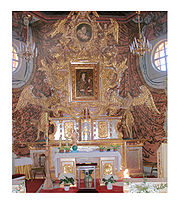
Gasawa
Encyclopedia


Znin County
Żnin County is a unit of territorial administration and local government in Kuyavian-Pomeranian Voivodeship, north-central Poland. It came into being on January 1, 1999, as a result of the Polish local government reforms passed in 1998. Its administrative seat and largest town is Żnin, which lies...
, Kuyavian-Pomeranian Voivodeship
Kuyavian-Pomeranian Voivodeship
-Transportation:Transportation infrastructure is of critical importance to the voivodeship's economy. Kuyavia-Pomerania is a major node point in the Polish transportation system. Railway lines from the South and East pass through Bydgoszcz in order to reach the major ports on the Baltic Sea...
, in north-central Poland. It is the seat of the gmina
Gmina
The gmina is the principal unit of administrative division of Poland at its lowest uniform level. It is often translated as "commune" or "municipality." As of 2010 there were 2,479 gminas throughout the country...
(administrative district) called Gmina Gąsawa
Gmina Gasawa
Gmina Gąsawa is a rural gmina in Żnin County, Kuyavian-Pomeranian Voivodeship, in north-central Poland. Its seat is the village of Gąsawa, which lies approximately south of Żnin and south-west of Bydgoszcz....
. It lies approximately 10 kilometres (6 mi) south of Żnin
Żnin
Żnin is a small town in Poland with a population of 14,558 . It is in the Kuyavian-Pomeranian Voivodeship and is the capital of Żnin County. The town is situated in the historic land of Pałuki and the Gniezno Lake Area on the river Gąsawka.-Etymology:The name originates from the Polish word...
and 43 km (27 mi) south-west of Bydgoszcz. The village has a population of 1,400.
Gąsawa received the city rights in 1388 and lost them in 1934.
It is famous as the place of the assassination of the Leszek I the White
Leszek I the White
Leszek I the White , also listed by some sources as Leszek II the White, was Prince of Sandomierz and High Duke of Poland from 1194 until his death, except for the short periods following when he was deposed as Polish ruler...
, prince of Poland (November 23, 1227). In 1600 Gąsawa hosted the Lubrański Academy
Lubranski Academy
The Lubrański Academy was a university college that was established in 1518 in Poznań by Bishop Jan Lubrański. It was the first school with university aspirations in Poznań .-History:The Academy's first rector was the Poznań humanist Tomasz Bederman...
which temporarily moved out of plague-stricken Poznań
Poznan
Poznań is a city on the Warta river in west-central Poland, with a population of 556,022 in June 2009. It is among the oldest cities in Poland, and was one of the most important centres in the early Polish state, whose first rulers were buried at Poznań's cathedral. It is sometimes claimed to be...
.
The main tourist attraction in Gąsawa is the 17th century wooden St. Nicolas Church with a unique collection of multi-layered mural paintings, the earliest from the 17th century, and the most recent from 1807.
The church itself, a larch construction with a slate roof, was in a such a bad state around 1850 that local officials asked the regional Prussian government to allow the church to be dismantled and build a new one instead. The response gave permission to only overhaul the building. Existing wall paintings were covered with a layer of reed and ordinary plaster, and forgotten for some 150 years.
The town name was spelled "Gonzawa" in some old documents.

